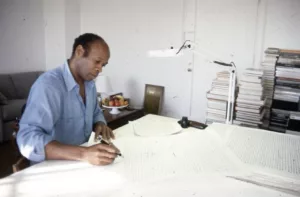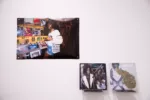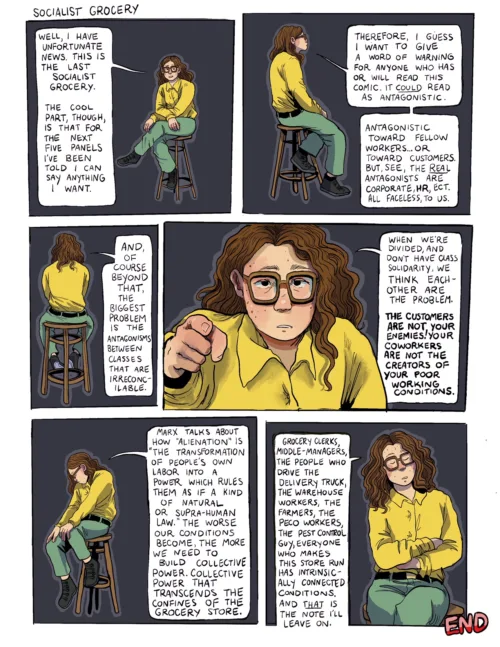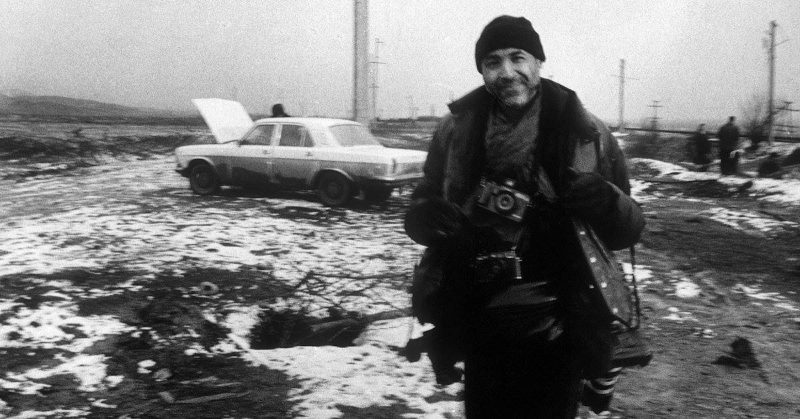
Death focuses the mind and steels the heart; it is, perhaps, the ultimate form of gravity. For Stanley Greene, a war photographer in his own class, death offered a crucible for humanity’s worst impulses.
When Stanley Greene died in Paris on Friday, 19 May at age 68, I found myself, like so many of his friends and colleagues around the world, deeply saddened. No longer would this ever-curious and nomadic American point his lens towards the criminals who were hiding out, or the victims just barely buried. He’d no longer scramble across a ravaged city, tramp through some tropical flood zone, or choke on the desert sands amidst the rusted carcasses of tanks and planes.
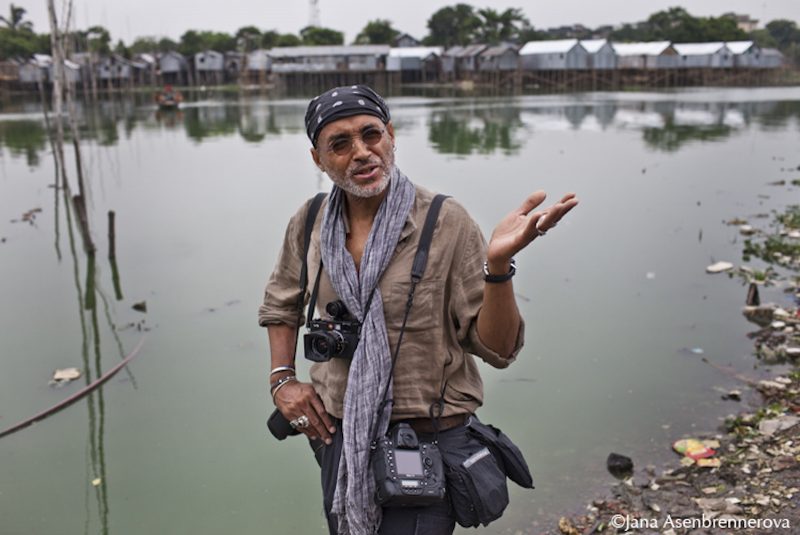
Clad in black leather jacket and pants, sporting sun glasses, cameras round his neck and his soft and pliant hands festooned with silver rings, Stanley Greene was the epitome of the rockstar war correspondent. And he was almost always just back from some hellhole with bad news.
Stanley, with a voice oddly sweet and soothing, would detail the most awful things humans have done to each other. He felt strongly that you needed to know. And he showed you (and the world) proof of such atrocities in Kabul, New Orleans, Haiti, Grozny, Rwanda, Chad, The Sudan, Baghdad…. [A slide show of some of his work can be seen here]
A lifetime chasing tragedy
His autobiography was aptly titled Black Passport (2009), a scrapbook and carnet de voyage of his personal and professional life. Both literal and metaphorical, Black Passport is a brutal take on the world as Stanley found it and moved through it. His actual passport was bloodied with blue and black ink stamped with arrivals and departures to and from what is now called conflict zones. But he always returned–usually to Paris, sometimes to Moscow–exhausted but eager to tell the world in The New York Times, Washington Post, Newsweek, Time Magazine, Libération, Le Monde….what the world didn’t know, or often what the world didn’t want to know. But a lifetime dodging bullets and freezing and bearing witness to entire communities that were destroyed, executed, wiped out by disease or famine or flood or war took its toll.
Greene writes in Black Passport:
“I think you can only do this for eight years. For eight years you can still keep the positive. If you stay at it longer than eight years, you turn. And not into a beautiful butterfly. You really turn. I see it in myself, I see it in all my friends and colleagues. I mean they are all victims of post trauma. We’re not the beautiful butterflies anymore. We become moths. We’re like moths flying to the flame. You know, sometimes your wings get singed or you just burn up. Get killed. Or you burn up inside. The drugs and the alcohol and the party and all of this is to push it away, push it away.”
The first time I met Stanley, he came over to my Paris studio to work on captioning and summarizing his White Lake chemical disaster photos from Dzerzhinsk, Russia. (“The Most Tainted Place on Earth,” New York Times Magazine, February 8, 1998). Stanley’s photographs told the story of an immense body of toxic “water” in this small Russian town where farmers continued to grow carrots and potatoes and heat their homes with dioxin-soaked coal they dug up from the ground.
Heartbreaking stories and haunting visuals
Over the years, I worked with Stanley on a number of proposals for his projects that were born from his work in the Caucasus and Chechnya. Open Wound (Trolley Press, 2004) was just one of his masterpieces from his forays into the wildest parts of the old U.S.S.R. A devastating book on the Russians’ 9 year war on Chechnya and its capital Grozny, Open Wound details the lives of Chechen rebels and their families fighting for their lives and independence. Women and child soldiers with their Kalishnakovs stand guard behind windows or share tea in crowded, damp and cold rooms. Sometimes, just hours later, those same people are photographed, shot dead and frozen in the snow.
There is heartbreak in almost every Stanley Greene photograph. A monograph on Katrina from 2006 produced by a tag team of four photojournalists, features Stanley’s cover shot of a mud-soaked house in New Orleans–a child’s doll lays half burned, half blackened by oil and sewage. If disaster tourism were a real thing (or a good thing), Stanley Greene’s photographs would beckon generations of visitors. His purpose though was to shine a light where darkness was the norm.
Born in Brooklyn, New York in 1949, Greene fell into photojournalism when, after years shooting rock bands in San Francisco in the 1970s, he met American photographer W. Eugene Smith. By 1986 Stanley had moved to Paris to work as a fashion photographer where he was “taking pictures of girls in Parisian cafés doing heroin.” When the Berlin Wall fell in 1989, he captured an iconic image, “Kisses to all”–a girl in a tutu balancing on the Wall with a champagne bottle. His work then focused on the disintegration of Communism, the Russian state and every flavor of war. It was, in a word, his calling.
Video interview with Stanley Greene
Greene signed on with Paris-based photo agency VU in 1991, and was in the Russian White House in Moscow in 1993 as Boris Yeltsin battled the Russian parliament he’d just dissolved during a coup attempt. The only Western photographer covering the violent struggle as Boris Yeltsin tried to bend Parliament to his will, Greene’s images of those hiding out in the White House and the attacks record what the world saw during that critical moment in Russian history–the second October Revolution.
Greene was obsessively attracted to the worst places on earth–the Union Carbide gas poisoning in Bhopal, India, genocide in Rwanda, long-term starvation and upheaval in Darfur’s non-stop bloody uprisings in all parts of the U.S.S.R. as it splintered and and war rained down across its 11 time zones.
Remembering a brilliant photographer
In looking over Stanley’s Instagram feed (only 82 images), I was struck by the longish notes and captions he added for each photo. One image of a boy staring out a window (perhaps on a train) was cloudy, purposely scratched and out of focus. Strikingly different from many of his other photographs–woman warriors, bomb-blasted buildings, children screaming from the back seats of cars–this photograph seems lifted from another world:
Like life sometimes we fade in and fade out, things come into focus then they disappear, on a winter day pressing your face against the window, you can feel the cold, but also the warmth of the moment, hard to explain, but there it is, when I was younger I did photo–print etchings, putting acid on the plates, scratching the plate, with all kind of metal objects, finding this image today, brought back that memory, of the days and nights doing print etchings in San Francisco, sharing this memory tonight, thinking of those days and nights when I use to press my face up against the cold windows of Russia, thinking about it does make me smile and feel all warm inside…
Sifting through the stories this beautiful and brilliant man told me these last 20 years I realize that most if not all of them were filtered through the gauze of death and narrated through the special lens of love he held out for the abused victims of war and nature. But he was aware of the power of images and understood the camera was a tool to achieve a specific end–expose the truth. He says in the video interview above, “We can’t be merchants of misery.”
Ten years ago in 2007, Greene, along with several close photographer friends, launched the photo agency Noor, in Amsterdam; Noor is Arabic meaning “Light.” In a very real way, Noor has fulfilled that vision, and Stanley’s calling.
I have a handful of Stanley’s books here, most with a note to me about art and writing and truth and friendship. He would invariably sign off with a note of respect and love – and mystery: “See you on the other side… Always somewhere…Stanley.”


